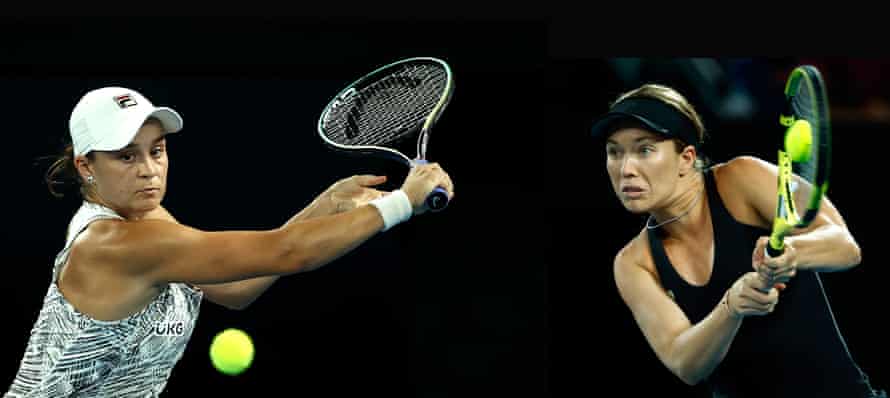It looks to be a sublime matchup of contrasts when first-time grand slam finalist Danielle Collins of the United States takes on Australian native and world No 1 Ash Barty in the Australian Open final on Saturday in Melbourne. While Barty, seeking her third major title, is the clear favorite she’ll have to stave off the inspired Collins, who is in the best form of her career.
For the 30th-ranked Collins, 28, reaching the final is the culmination of years of hard work and stick-to-itiveness as her powerful, high-risk, aggressive game is finally paying dividends. Further, Collins’ rebound from surgery to treat endometriosis last spring has given her a renewed sense of optimism and focus. Before her semi-final demolition of Iga Swiatek, one of the pre-tournament favorites, Collins spoke about her physical recovery. “It finally got to the point where I couldn’t deal any longer with it physically or mentally. Once I was able to get the proper diagnosis and the surgery, I feel like it’s helped me so much – not just from a physical standpoint but from a mental standpoint.” Indeed, since July, Collins has a sterling 32-7 singles record.
Collins’ emergence at the top of the sport runs counter to the prevailing norms in women’s tennis. Compared to her American peers who reached a high level of success or renown at a young age (the Williams sisters, Sofia Kenin, Sloane Stephens, Madison Keys, Coco Gauff among others), Collins is coming into her own in her late 20s, normally late middle-age in women’s tennis years. Consider, Collins didn’t even turn pro until she was 22, after a stellar collegiate career that saw her win two NCAA titles at the University of Virginia.
The all-court, go-for-broke game that Collins possesses has always made her one of the most enjoyable players for fans to watch. And while many of the high-ranked women have ferocious groundstrokes, what makes Collins unique is that she is just as adept in the forecourt, allowing her to finish off points in swift fashion. Yet part of the reason why Collins’ game has taken longer to mature into the top-tier player she has become is that her on-court decision-making was lacking. But she has now married her all-court abandon with a newfound strategic acumen and increased mental focus, rapidly developing into one of the most dangerous players on tour. (On the men’s side Denis Shapovalov is undergoing a similar transformation.) Collins’ full arsenal of shots was on view during her comprehensive beating of the slam champion Swiatek on Thursday. It was perhaps the finest win of her career.
So far.

Collins would love to play as soundly in the final against Barty as she did in the semi-finals. This is a much, much tougher ask. As noted above, this is a final with as many contrasts as one could hope for. The differences are numerous: Barty turned pro at 14, while Collins was 22; Collins plays with extraordinary power and takes high risks to pummel her foes, while Barty utilises touch and a staggering array of spins and angles to stymie her opponents; Barty is relatively diminutive by women’s tennis standards, at 5ft 5in while Collins is 5ft 10in. The two have played four times, with Barty leading the rivalry 3-1. Collins won their last meeting, at an Australian Open tune-up event in 2021.
Look for the service return to be the key to the match, especially for Collins. While Barty doesn’t possess the power of Collins, she is nonetheless one of the best servers in women’s tennis – if not the best – with a simple, natural motion and a preternatural ability to place the ball in all corners of the box. To wit: during this Australian Open Barty had a streak of 63 consecutive service games held.
Which is why Collins will have to take chances with her return, especially on the second serve. In her semifinal vanquishing of Swiatek, Collins won an astounding 86% of second-serve return points (including seven all-out winners). It’ll be imperative for Collins to dominate court-positioning early in points so she can immediately put Barty on the defensive. Collins will likely move forward into the court on the return, especially on Barty’s second deliveries.
Finally, will the ever-lurking force at any slam final – nerves – be a deciding factor? All the pressure, as well as the home-crowd support, will be on the Barty’s side. The immensely affable home favorite knows the history she’s up against: an Australian woman hasn’t won her home Slam since Chris O’Neil in 1978 (Mark Edmondson was the last Aussie man to win, in 1976). How she handles the expectations may well determine the outcome of the match.
Whatever transpires on a muggy Melbourne Saturday evening, it appears to be a contest that’s guaranteed to please.




